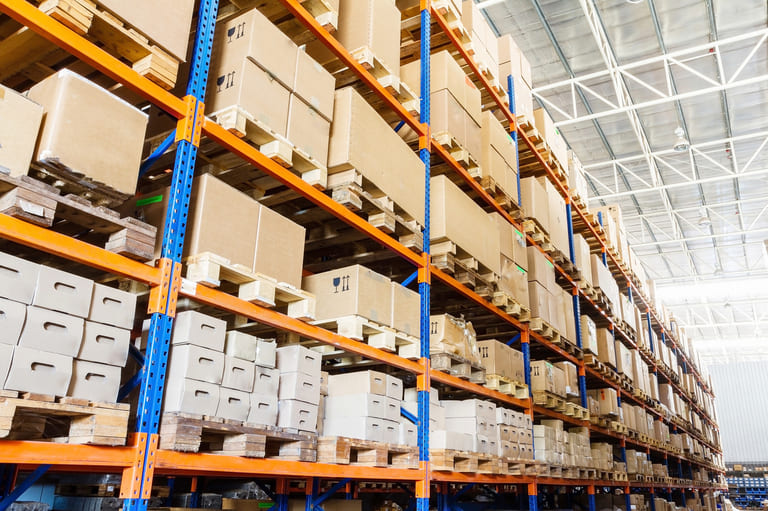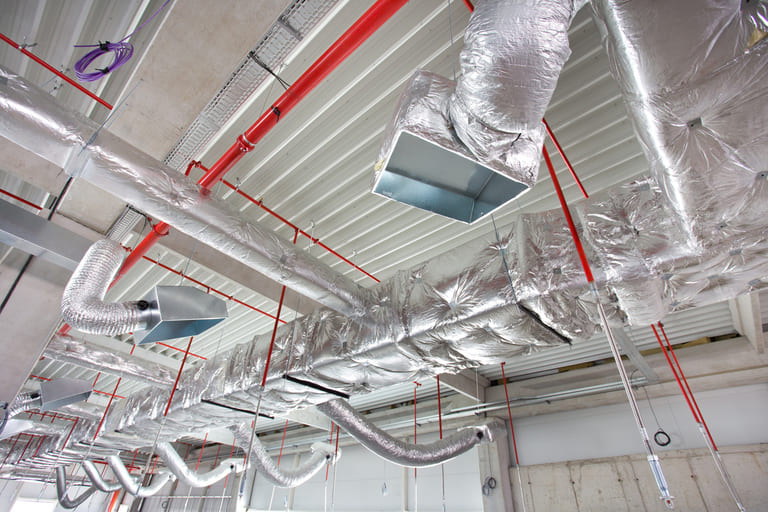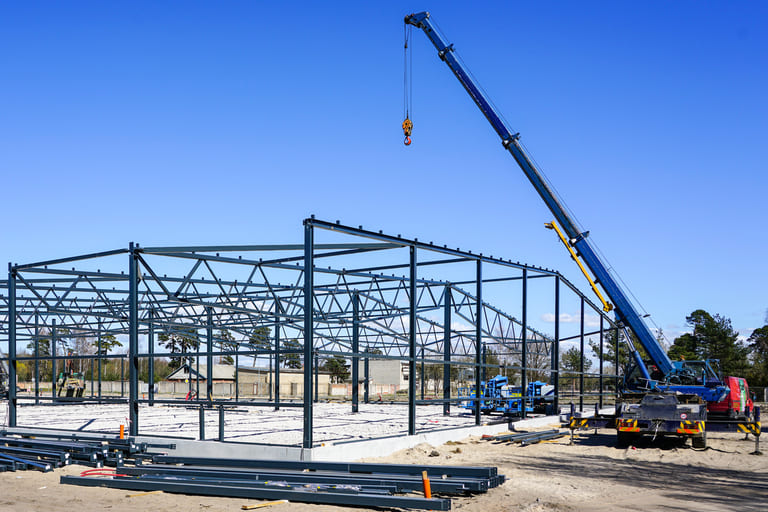

Taiyo Kogyo Column
Thorough explanation of “storage” important for warehousing and logistics|Explanation of storage methods, efficiency improvement, and points to note
2025.05.02

Storage operations in logistics operations are more than simply placing goods in one place.
It is an important process that requires strategic planning and advanced skills.
Proper storage operations not only ensure safety, but also affect distribution efficiency and cost reduction.
This article explains the basics of storage, points to improve efficiency, and cautions.
What is "storage" in a warehouse?

Storage” in warehousing and distribution operations refers to the safe and proper management of goods and cargo in warehouses and other facilities.
This is important for the smooth flow of goods from receiving to shipping, and requires accurate control of quantity and quality.
For example, temperature and humidity control is essential for food and pharmaceutical products, while storage of metal products requires rust and moisture proofing.
These controls ensure an optimal environment for the type and characteristics of the products.
In addition, efficient storage can reduce costs and optimize operations.
The implementation of proper storage contributes to the overall quality of logistics and is an essential element in ensuring reliability.
Role of Storage in Warehouses

In warehousing and distribution operations, it is essential to store goods before and after delivery.
Storage is more than just putting things away; it plays an important role in maintaining the quality and value of goods.
Particularly in the field of logistics, the importance of the role that storage plays is attracting attention, and efficient management is required. This section explains the role of storage in warehouses.
Maintaining product quality
Storage in an appropriate environment is important to maintain product quality.
Temperature and humidity control is essential, especially for food and pharmaceutical products.
On the other hand, storage of metal and machine parts requires measures to prevent rust and moisture.
Inadequate control of these controls increases the likelihood of poor quality.
Improve customer satisfaction
Providing a well-equipped warehouse and facilities ensures proper storage of goods.
Properly stored goods can maintain a high level of quality and safety, giving peace of mind to the customer who ultimately gets the goods.
This sense of security leads to trust in the company, which in turn increases the likelihood of repeat purchases.
The role of storage in logistics goes beyond mere inventory control and is an important element in improving customer satisfaction.
Risk minimization
Warehousing always involves risks of theft, loss, damage, and spoilage.
Especially in the case of expensive or valuable goods, these risks are even higher and require proper management.
Furthermore, if the goods are damaged or spoil, customer complaints and compensation issues may arise, which would be a significant loss to the company.
Therefore, it is extremely important in logistics management to take measures to minimize these risks.
Storage method for each product
Proper storage of goods is essential to maintaining quality.
For example, perishable foods must be kept at low temperatures, and electronic equipment must be protected against humidity.
Incorrect storage can lead to deterioration and undermine customer confidence.
Value can be maintained by understanding the types and characteristics of products and managing them in an appropriate environment.
This section describes how to store each product.
Metal products and machine parts
It is important to prevent corrosion of metal products and machine parts due to moisture and rust.
Use desiccants, moisture-proof sheets, and rust inhibitors in the storage area to create an appropriate environment.
In addition, choosing the right packing materials will help prevent damage during transportation and long-term storage.
In particular, precision mechanical parts must be stored safely using individual packaging and cushioning materials.
Regular inspections are also essential.
Chemical products and cosmetics
Cosmetics and chemicals are susceptible to moisture and ultraviolet rays, and are prone to corrosion and discoloration.
Therefore, it is essential to employ appropriate storage methods to maintain quality.
Specifically, the storage area should be equipped with facilities that can adjust temperature and humidity to minimize environmental changes.
In addition, UV-blocking sheets and protective films must be utilized to prevent the effects of UV rays on the product and keep it safe.
Electronic components and medical equipment
Electronic components and medical equipment are susceptible to static electricity, so storage areas must be equipped with antistatic facilities.
In addition, packaging materials and transportation methods must also be static-proof.
The use of packing materials with antistatic properties and appropriate humidity control will help maintain product quality.
In particular, safe storage is essential for medical equipment, which requires precision. Choose an appropriate method and prevent damage to your products.
Fresh food and pharmaceuticals
Proper storage of food and pharmaceutical products is essential to maintain their quality.
It is important to control temperature and humidity and maintain sanitary conditions.
In particular, perishable foods should be kept at low temperatures, and pharmaceuticals should also be stored in an appropriate environment.
Clean facilities are required to reduce the growth of microorganisms.
Therefore, it is essential to use dedicated facilities such as clean rooms and refrigerated facilities to ensure safety and quality.
Valuable and expensive goods
Valuables and expensive items require strict security measures.
Install security cameras and security systems to prevent theft and loss.
In addition, utilizing a lockable storage unit or a fireproof safe will increase safety.
In addition, it is important to properly control the temperature and humidity in the storage area to create an environment in which products do not deteriorate.
Minimize risk by taking thorough safety precautions.
hazardous materials
Storage of hazardous materials requires appropriate methods according to their characteristics.
For example, flammable materials should be stored in explosion-proof containers because of the high risk of fire.
Radioactive materials must be strictly controlled and must be stored in dedicated facilities.
Management of storage information is also important and requires accurate records of type, quantity, expiration date, and disposal method.
In addition, they must be disposed of at the appropriate time.
Access control to storage areas and preparation for fire, explosions, and earthquakes are also essential.
Location Management, an important management method in warehouses

Location management is a method of controlling the storage location of goods in a warehouse by number or street address, and is essential for efficient storage and operations.
This management method allows us to know exactly where the merchandise is located, eliminating the need to search for it and improving operational efficiency.
Specifically, products will be organized by shelf number and part number to create a system that allows anyone to quickly find what they need.
As a result, complex inventory management is simplified and smooth handling is possible even when a wide variety of products are present in the warehouse.
There are three main types of location management methods: fixed location, free location, and double transaction.
Each is described in detail below.
fixed location
Fixed location is a method of storing each product in a fixed location.
The process is simple and user-friendly.
However, the layout must be flexible as it must be changed to accommodate inventory fluctuations and product replacements.
free location
Free-location is a flexible method of storing goods in available space.
This allows efficient use of warehouse space.
However, since the storage location of goods changes each time they are stored, proper management is required. If management is not systematized, it becomes difficult to keep track of storage locations, which can lead to inefficient operations.
Implementing an appropriate system will ensure smooth operation of the operation and lead to efficient warehouse management.
double transaction
Double transaction is a warehouse management method that combines fixed location and free location.
Picking areas are located in fixed locations to reduce worker travel distance.
On the other hand, free locations are used for stocking areas to optimize storage space.
This improves work efficiency and facilitates inventory management.
Proper location management is expected to reduce warehouse operating costs and improve operational efficiency.
Key to Efficient Warehouse Storage

To improve warehouse storage efficiency, it is first important to optimize the layout and make effective use of space. The following is an explanation of key points.
Optimize warehouse layout
The first step in improving warehouse storage efficiency is to optimize the layout.
Warehouses not only store goods, but also perform a variety of logistics tasks, so they must be designed with efficient flow lines in mind.
In particular, considering the layout arrangement based on work processes such as “receiving,” “inspecting,” “storing,” “packing,” and “shipping” will help reduce travel distances and improve work efficiency.
As a result, not only are labor and administrative costs expected to be reduced, but the risk of product mix-ups is also reduced, contributing to improved overall accuracy.
Review of storage space
By reviewing the storage space in the warehouse, more products can be stored in the same area, thereby improving storage efficiency.
This storage efficiency is one of the key indicators of logistics management and is the standard by which warehouse space utilization is measured.
Improved efficiency is key if you want to store more goods or have more work space.
To do this, it is important to first check for wasted space and excess losses.
In particular, it is effective to identify the three losses that cause storage inefficiency and take remedial measures.
Each loss will be explained in detail.
mountain chipmunk (esp. the Siberian chipmunk, Tamias sibiricus barbatulus)
To improve warehouse storage efficiency, it is important to reduce unnecessary gaps between products.
Inefficient placement of storage shelves wastes space. Inconsistency between product size and shelf size is also a problem.
Different sized products and shelves can easily create unnecessary gaps.
To prevent pile-chipping losses, regularly review the layout and consider optimal storage methods.
plane loss
The use of flat space is important to improve storage efficiency in warehouses.
If there are many flat surfaces where products are not placed, it leads to waste of space.
Proper placement and optimized aisle widths reduce waste and maximize storage capacity.
height loss
To improve warehouse storage efficiency, it is important to review storage space.
In particular, “height loss” results in wasted space.
For example, if a large space remains between the shelf and the ceiling, the space cannot be used effectively.
In order to increase the amount of storage per square foot, it is necessary to devise ways to stack products.
By considering three-dimensional storage, more products can be stored in a limited space.
Efficient storage leads to smoother operations and cost savings.
Installation of storage facilities
There are various means of warehouse storage, including direct storage using pallets and the use of storage facilities.
In order to store a large number of products within a particularly limited space, storage facilities such as stacked racks and high-rise racks are particularly effective.
This allows for three-dimensional utilization of space and improved storage efficiency.
High-rise racks, in particular, make effective use of the height of the warehouse, allowing for the storage of large quantities of goods without taking up floor space.
However, there are a few things to keep in mind when installing high-rise racks.
Usually, racks are three-tiered, with each tier used to store products.
However, placing important items at the top requires a forklift or other machine to remove them, increasing the workload.
In addition, since specialized operators are essential to operate the machines, this can lead to work delays in situations where manpower is in short supply.
As a result, it may take longer to retrieve goods, reducing the efficiency of the entire warehouse.
To prevent these problems, it is recommended that frequently used and important items be placed on the bottom of the rack.
This facilitates manual removal and improves work speed.
To achieve optimal storage efficiency, it is important to consider the importance and frequency of use of products and effectively arrange them.
Precautions for storage in warehouses

In order for warehouse storage operations to be efficient, an environment must be created where mistakes are unlikely to occur.
If the storage location is difficult to find or the flow line is inappropriate, it will increase the time spent searching for the item and cause delays in business operations.
Warehouses with inadequately classified locations are also prone to erroneous shipments and inventory management confusion.
Therefore, it is important to regularly review the placement of products to ensure that they can be found smoothly.
In a warehouse, diverse operations occur, including not only storage but also receiving, moving, packing, and shipping.
Focusing solely on storage efficiency can reduce overall warehouse productivity.
For example, over-optimizing space utilization may result in insufficient work space and wasted effort in pickup and packing operations.
Therefore, it is important to design a well-balanced layout that provides space for movement and work areas.
Furthermore, to prevent erroneous shipments, it is necessary to clearly demarcate each storage area and devise ways to easily identify products.
Proper labeling and management systems can improve the accuracy of the work.
In addition, aisles and work areas should be adequately spaced to allow for smooth operations.
For efficient warehouse operations, continue to optimize the layout and work environment.
Use of Warehouse Management System (WMS)

A warehouse management system (WMS) is software designed to improve the efficiency of inventory management and ordering operations, helping to improve storage efficiency.
Although not directly related to storage, it is indirectly effective through accurate inventory information and optimization of operations.
For example, proper inventory placement and picking operations can be made more efficient, and the entire warehouse can be operated more smoothly.
This section describes the main functions of the WMS.
Inventory Control Functions
Track incoming and outgoing shipments in real time for accurate inventory status.
Immediate confirmation of inventory counts and storage locations prevents overages and shortages and optimizes costs.
Lot management and due date management functions ensure proper inventory placement while maintaining quality.
In addition, FIFO can be automated, reducing waste and facilitating the smooth circulation of inventory.
This allows for efficient warehouse operations.
information management function
Information can be consolidated in real time, and inventory status and work progress can be shared with related departments.
This allows for greater visualization of operations and centralized management of information.
In addition, it also streamlines the paperwork process and reduces labor through automatic issuance of forms and labels.
In addition, by linking with other systems, the system helps improve operational efficiency and accuracy through integrated management of the entire logistics operation.
Receiving and shipping management functions
Streamline inventory pickup and shipping based on order data.
By utilizing the information on the arrival schedule, smooth progress in order processing is also possible.
The receiving management function assists in storing goods arriving at the warehouse in the proper location.
It also serves to confirm quantity variances and deadlines and facilitate later shipments.
In the shipping management function, products are taken out according to the instructions, and then packed and shipped according to the procedure.
This is expected to prevent erroneous shipments and improve work efficiency.
The Warehouse Management System (WMS) centrally manages everything from receiving to shipping, increasing the accuracy and productivity of logistics operations.
Benefits of a Warehouse Management System (WMS)

Learn more about the benefits of a warehouse management system (WMS).
Reduction of errors
Manual errors are greatly reduced. Inventory information is more accurate, reducing the risk of erroneous shipments and cancellations.
Warehouse operations are monotonous and prone to errors, but a WMS can compensate for the loss of attention.
Data management utilizing barcodes also prevents input errors.
As a result, operational efficiency is improved and unnecessary costs are reduced. It also contributes to improving a company’s competitiveness.
Reduction of workload
Reduced workload. Automated processes and efficient work procedures allow employees to perform their tasks quickly and easily, thereby reducing labor costs and increasing employee satisfaction.
In addition, overall work efficiency is also improved by reducing the number of manual tasks.
In particular, in inventory management, it is necessary to deal not only with incoming shipments and outgoing shipments, but also with unexpected fluctuations due to returned goods.
In the past, it was time-consuming to check shipping history, revise inventory, and review receiving schedules, but by utilizing the return management function of the WMS, these tasks can be made much more efficient.
As a result, it is possible to respond in a shorter time, simplifying the workflow and reducing the number of personnel.
Realization of business standardization
Warehousing requires experience, and inventory locations in particular tend to rely on the memory of skilled workers.
Any rearrangement can cause confusion, resulting in erroneous shipments and work delays.
However, with a warehouse management system (WMS), locations can be accurately managed and information can be quickly shared with all staff.
This prevents gerrymandering and ensures that everyone can perform their tasks with consistent quality.
The standardization of operations will be improved, leading to increased productivity and reduced errors, thus ensuring stable operations.
State-of-the-art warehousing technology

The latest warehousing technologies are revolutionizing the logistics industry, with the latest technologies automating and streamlining the storage process. Here are some of the high-profile technologies.
Autonomous Mobile Robot (AMR)
In recent years, advances in robotics and automated driving technologies have accelerated the automation of warehousing operations.
Autonomous Mobile Robots (AMR) in particular are attracting attention as a technology that will revolutionize warehouse operations.
AMR is equipped with sensors, cameras, and AI to move autonomously while adapting to dynamic environments.
Because obstacles can be detected and avoided in real time, the system is not tied to a fixed route and can operate flexibly.
This feature makes it easily adaptable to changes in warehouse layout and improves operational efficiency.
Major uses include assisting with picking, stock replenishment, and carrying tasks in preparation for shipping.
The introduction of AMR is expected to improve the efficiency of warehouse operations and reduce the human workload.
Automated warehouse system (AS/RS)
Automated Storage System (AS/RS) is a technology that mechanizes storage and retrieval operations in a warehouse.
Using a crane or shuttle, goods are stored in designated locations and automatically removed when needed.
This reduces manpower and improves the efficiency and accuracy of the operation.
It also makes effective use of limited space and can handle a large volume of product management.
In addition, it reduces work time and costs and contributes to more accurate inventory control.
IoT Sensors
The latest warehousing technology utilizing IoT sensors enables real-time inventory management.
Sensors constantly monitor the position and quantity of goods, eliminating the need for manual verification.
This allows for an accurate and quick inventory status.
It can also instantly detect out-of-stocks or overstocks and plan for appropriate replenishment.
As a result, logistics efficiency can be improved and cost savings can be expected.
summary
Storage” in warehousing and logistics is not just inventory control, but an important process that directly affects the maintenance of product quality, operational efficiency, and even customer satisfaction.
Selecting an appropriate storage method and creating an environment appropriate to the product characteristics will prevent quality deterioration and ensure safety.
In addition, optimization of warehouse layout, location management, and storage facilities are essential to improve storage efficiency.
Furthermore, the use of a warehouse management system (WMS) and incorporation of the latest automation technology will improve the accuracy of operations and reduce the human workload, enabling the smooth operation of the entire logistics operation.
Proper storage practices help companies strengthen their competitiveness, reduce costs, and provide reliable logistics services.
Tent warehouses are increasingly being introduced by many companies as a means to further improve the quality of their logistics services.
Tent warehouses are constructed by assembling a steel frame and covering it with a sheet membrane, and can be built at low cost and in a short construction period.
It is also durable and weather resistant, and is so bright during the day that no lighting is needed, improving work efficiency.
Consider tent warehousing as a means to achieve efficient logistics services and, ultimately, warehouse operations.
If you are interested in the Tent Warehouse, please contact Taiyo Kogyo Corporation, a manufacturer that has been in business for 100 years and has the largest market share in Japan.
Tent Warehouseへの
Contact us

What you need to know when building a warehouse
We've packed it all in.
Clues to solving the 2024 problem
<
・Don't know where to start in building a warehouse
・Want to build a warehouse economically
・Want to know which type of warehouse to build
・Anyway, want to learn the basics of warehouse construction
・Worried about the 2024 problem, but don't know what to do
Related Articles
- TOP>
- Taiyo Kogyo Column>
- Thorough explanation of “storage” important for warehousing and logistics|Explanation of storage methods, efficiency improvement, and points to note








